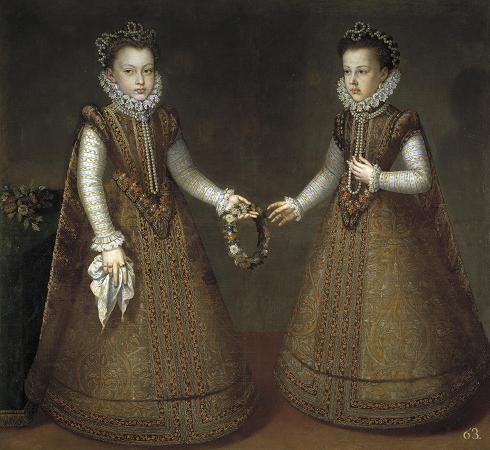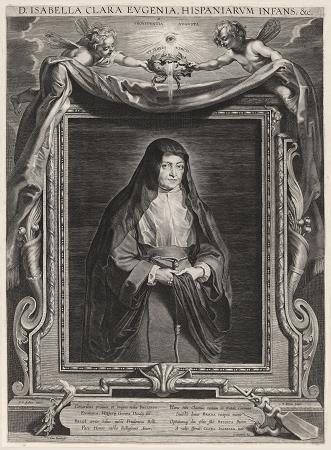Isabella Clara Eugenia (1566 - 1633). Isabella Clara Eugenia was sovereign of the Spanish Netherlands in the Low Countries and the north of modern France, together with her husband Albert VII, Archduke of Austria. In some sources, she is referred to as Clara Isabella Eugenia. By birth, she was an infanta of Spain and Portugal. Isabella Clara Eugenia of Austria was born in the Palacio del bosque de Valsaín, Segovia on 12 August 1566, daughter of Philip II of Spain and his third wife Elisabeth of Valois. Her father, Philip II, was reportedly overjoyed at her birth and declared himself to be happier on the occasion than he would have been at the birth of a son. Philip already had a male heir, Carlos, Prince of Asturias, the child of his first marriage to Maria Manuela, Princess of Portugal; however, father and son had never developed a close rapport and frequently lived in conflict with one another. Isabella's mother had originally been betrothed to Don Carlos, but political complications unexpectedly necessitated her marriage to Philip instead. Despite the significant age difference between them, Philip was very attached to Elisabeth, staying close by her side even when she was ill with smallpox. Elisabeth's first pregnancy in 1564 ended in a miscarriage of twin daughters. She later gave birth to Isabella Clara Eugenia on 12 August 1566, and then to Isabella's younger sister Catherine Michelle 10 October 1567. Elisabeth miscarried a daughter in 1568 and died the same day. Isabella grew up with her sister, beloved by her father and her stepmother and first cousin, Anna of Austria, Philip's fourth wife. Philip ultimately fathered five children by Anna, all of whom died in early childhood except his heir, Philip III. Philip II is frequently characterized as having been affectionate towards his offspring, there exists numerous letters addressed from him to his daughters which testify his deep attachment to them, each letter lovingly signed Your good father. Isabella was also the only person whom Philip permitted to help him with his work, sorting his papers and translating Italian documents into the Spanish language for him. Isabella remained close to her father until his death on 13 September 1598, and served as his primary caretaker during the last three years of his life, when he was plagued by gout and frequent illness. Since 1568, at the age of two, Isabella Clara Eugenia was promised to marry her cousin Rudolf II, Holy Roman Emperor, son of Emperor Maximilian II and her aunt Maria. Isabella Clara Eugenia, however, had to wait for more than 20 years before the eccentric Rudolf declared that he had no intention of marrying anybody. After her uncle, Henry III of France, was assassinated by the fanatical young monk Jacques Clément on 2 August 1589, Philip II claimed the French crown on behalf of Isabella Clara Eugenia despite France's Salic law, which forbade cognatic succession. At any rate, Isabella Clara Eugenia's mother had ceded any claim to the French crown with her marriage to Philip II. However the Parlement de Paris, in power of the Catholic party, gave verdict that Isabella Clara Eugenia was the legitimate sovereign of France. The Huguenot leader, Henry III of Navarre, the rightful King of France by traditional French inheritance laws, ultimately made good his claim to the throne, converted to Catholicism and was crowned in 1594. Her father decided to cede the Spanish Netherlands to her on condition that she marry her cousin, Albert VII, Archduke of Austria. They were to reign over the Netherlands jointly as duke/count and duchess/countess. They were to be succeeded by their descendants according to the male-preference cognatic primogeniture but should a female succeed, she was required to marry the King of Spain or the person chosen by the King of Spain. It was also stipulated that, should they have no children, the Netherlands would revert to the King of Spain upon the death of either spouse. On 18 April 1599, being 33 years old, she married Albert, the younger brother of her former fiancé Emperor Rudolf II. Albert was the joint sovereign of the Seventeen Provinces and the former viceroy of Portugal. As Albert also was the Archbishop of Toledo, he had to be released from his religious commitments by Pope Clement VIII before the wedding could take place. Shortly before Philip II died on 13 September 1598, he resigned the thrones of the Netherlands in favor of Isabella and her fiancé. Beginning in 1601, the couple ruled the Spanish Netherlands together, and after Albert's death Isabella was appointed Governor of the Netherlands on behalf of the King of Spain. A false anecdote links Isabella, the siege of Ostend, and the horse coat colour isabelline.
more...








